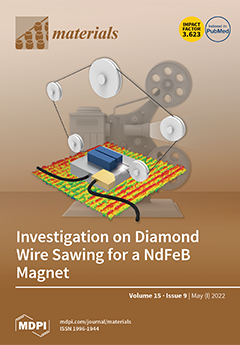Magnetic wood is a composite material that achieves harmony between both woody and magnetic functions through the active addition of magnetic characteristics to the wood itself. In addition to showing magnetic characteristics, magnetic wood offers low specific gravity, humidity control and acoustic absorption ability. It has potential for broad applications in the fields of electromagnetic wave absorption, electromagnetic interference shielding, furniture, etc. This work reports on the synthesis of Fe
3O
4 nanoparticles (NPs) in wood from three tropical species (
Pinus oocarpa,
Vochysia ferruginea and
Vochysia guatemalensis) using a solution of iron (III) hexahydrate and iron (II) chloride tetrahydrate with a molar ratio of 1.6:1 at a concentration of 1.2 mol/L ferric chlorate under 700 kPa pressure for 2 h. Afterward, the wood samples were impregnated with an ammonia solution with three different immersion times. The treated wood (wood composites) was evaluated for the weight gain percentage (WPG), density, ash content and Fe
3O
4 content by the Fourier transform infrared spectroscopy (FTIR) spectrum, X-ray diffraction (XRD) and vibrating sample magnetometry (VSM). The results show that the species
P. oocarpa had the lowest values of WPG, and its density decreased in relation to the untreated wood, with lower ash and Fe
3O
4 NP content. The XRD and some FTIR signals associated with changes in the wood component showed small differences from the untreated wood. Fe
3O
4 NPs presented nanoparticles with the smallest diameter of (approx. 7.3 to 8.5 nm), and its saturation magnetization (M
s) parameters were the lowest. On the other hand,
V. guatemalensis was the species with the best Ms values, but the wood composite had the lowest density. In relation to the different immersion times, the magnetic properties were not statistically affected. Finally, the magnetization values of the studied species were lower than those of the pure Fe
3O
4 nanoparticles, since the species only have a certain amount of these nanoparticles (NPs), and this was reflected proportionally in the magnetization of saturation.
Full article






